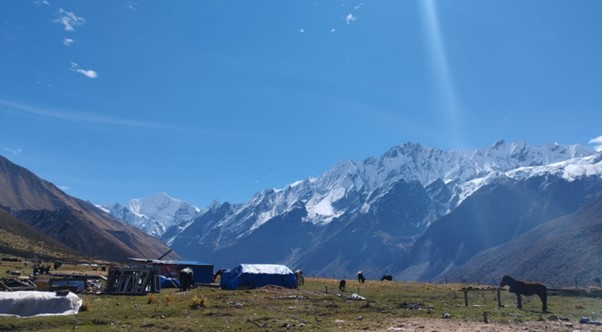Langtang Valley Trek: Quieter Trails, Short Itinerary & Family-Friendly – Your Ultimate Guide

Nepal is home to some of the most famous trekking destinations in the world, but beyond the buzz of Everest and Annapurna lies an underrated gem the Langtang Valley Trek. Known for its peaceful paths, cultural depth, and stunning mountain views, this trek is ideal for those seeking a short, scenic, and authentic Himalayan experience close to Kathmandu. Perfect for families, beginners, and anyone short on time, Langtang Valley offers the best of Nepal without the crowds.
This in-depth guide covers everything you need—from reasons to choose this trek to essential tips, highlights, routes, and what makes Langtang perfect for first-timers and families alike.
Langtang Valley Trek Highlights
Dive into Tamang Heritage in Langtang
- Tamang Hospitality: Friendly locals, cultural interactions, and teahouse warmth.
- Kyanjin Gompa Monastery: Visit a centuries-old spiritual site nestled in the mountains.
- Buddhist Symbols Along the Trail: Explore mani walls, chortens, and prayer wheels.
- Resilience After the Earthquake: Witness stories of recovery and strength in rebuilt villages.
Himalayan Beauty in Every Step
- Langtang’s Diverse Landscapes: Hike through forests, riversides, yak meadows, and glaciers.
- Langtang Lirung (7,234m): Towering above the valley throughout your journey.
- Langtang Khola River: A constant presence flowing beside your path.
- Yak Pastures & Open Valleys: Classic Himalayan imagery that defines this region.
- Wildlife in Langtang: Look out for red pandas, Himalayan tahrs, langurs, and bird species.
Why Choose Langtang Valley Trek? Explore Nepal’s Quietest Himalayan Trail
Planning a trek in Nepal? Langtang stands out with its unique combination of tranquility, cultural immersion, and Himalayan beauty.
The Peaceful Alternative to Everest & Annapurna
If you’re looking for a quiet trail far from tourist-packed routes, Langtang is the answer.
- Remote & Peaceful Trekking Experience: Enjoy serene trails with fewer trekkers and more wildlife.
- Eco-Friendly Adventure: Less foot traffic means reduced environmental impact in Langtang National Park.
- Wildlife Spotting Opportunities: Chance to see red pandas, Himalayan deer, langurs, and unique birdlife.
- Deeper Cultural Connection: More authentic interactions with local Tamang communities.
Short Itinerary-Flexible & Perfect for Busy Travelers
Searching for a short Himalayan trek near Kathmandu? Langtang’s 6–8 day itinerary is perfect.
- Ideal for 1-Week Treks in Nepal: Time-efficient without compromising on scenery or experience.
- Budget Trekking in the Himalayas: Save money on food, guides, permits, and transport.
- Easier Altitude Profile: Less physically demanding than longer, high-altitude treks.
- Best Trek for First-Time Trekkers: A great way to get introduced to Nepal’s trekking culture.
Family-Friendly Trek in Nepal: Great for All Ages
Langtang is one of Nepal’s few treks suitable for families with children or older travelers.
- Moderate Trail Difficulty: Gentle ascent and manageable daily walking distances.
- Safe Acclimatization at Kyanjin Gompa: Prevent altitude sickness with a well-placed rest day.
- Varied Natural Scenery for Kids: Waterfalls, forests, snowy peaks, and yak pastures keep all ages engaged.
- Cultural Education for Children: Visit monasteries, meet local families, and learn about Tamang heritage.
- Family-Friendly Lodging on Trek: Cozy teahouses provide warm meals and basic comforts.
Langtang Trek Access – Best Trek Near Kathmandu Without Flights
Unlike Everest or Annapurna treks, Langtang is fully accessible by road—no flights required.
- Road Trip to Syabrubesi – Langtang Trailhead: 6–7 hour drive from Kathmandu with scenic views.
- Avoid Domestic Flight Delays in Nepal: No risk of cancellations or rescheduling.
- Low-Cost Travel Option: Jeeps and buses make Langtang one of the most affordable treks.
- Enjoy the Journey: The drive offers a glimpse into rural Nepali life and beautiful river valleys.
Tamang Culture on the Langtang Trek – A Rich Heritage Experience
Immerse yourself in the unique culture of the Tamang people, the heart and soul of the Langtang region.
- Cultural Diversity in the Langtang Region: Influenced by Tibetan traditions and Buddhism.
- Hospitality in Local Teahouses: Warm welcomes, homemade meals, and genuine smiles.
- Spiritual Touchpoints on the Trail: Explore monasteries, chortens, and sacred mani walls.
- Learn Through Travel: Gain insights into a lesser-known yet vibrant ethnic group in Nepal.
How to Plan Your Langtang Valley Trek?
Planning your Langtang Valley Trek properly ensures a smoother, safer, and more fulfilling Himalayan adventure. This section outlines everything you need to consider—from choosing the best trekking season to arranging transportation, permits, packing, budgeting, and staying safe at altitude.
Best Time to Trek Langtang Valley – Seasonal Weather & Trail Conditions
Choosing the right season is essential for the best trekking experience in Langtang. Weather, visibility, and trail safety can vary significantly.
- Autumn (September–November): The most popular season with clear skies, stable weather, and crisp mountain views.
- Spring (March–May): Warm days, blooming rhododendrons, and great visibility make this another ideal time.
- Winter (December–February): Quieter trails and stunning snow-capped scenery, but cold temperatures require proper gear.
- Monsoon (June–August): Not recommended due to heavy rainfall, leeches, and slippery trails—though the landscape is lush.
How to Reach Langtang Trailhead – Kathmandu to Syabrubesi Transportation Options
Reaching Syabrubesi, the starting point of the Langtang trek, is an adventure in itself. You can get there by road from Kathmandu.
- Public Bus to Syabrubesi: Budget-friendly option; departs daily from Machhapokhari Bus Park, takes 7–9 hours.
- Private Jeep to Langtang Trailhead: More comfortable, faster, and suitable for groups or families with children.
- Road Conditions: Expect rough, winding roads—especially challenging during the monsoon season.
Langtang Trekking Permits – What You Need and How to Get Them
You’ll need two key permits to trek in the Langtang region. These are typically arranged in Kathmandu or by your trekking agency.
- Langtang National Park Entry Permit: Required to enter the park; available at the Nepal Tourism Board or at the park gate.
- TIMS Card (Trekkers’ Information Management System): Mandatory for safety and tracking; available from TAAN or authorized agencies.
- Required Documents: Bring photocopies of your passport and two passport-sized photos for permit processing.
Packing List for Langtang Valley Trek – What to Bring for Comfort & Safety
Efficient packing makes a big difference in your trekking experience. Think in layers and prioritize weather versatility.
- Clothing: Layered outfits (base, insulation, outer shell), quick-drying materials, fleece jacket, windproof gear.
- Footwear: Trekking boots (well broken-in), lightweight shoes for camp, quality socks.
- Head & Hand Gear: Sun hat, warm hat, gloves, neck gaiter or buff.
- Sleeping Equipment: Sleeping bag rated for -10°C or lower, sleeping bag liner for hygiene and warmth.
- Essential Gear: Daypack, duffel bag, trekking poles, reusable water bottles or hydration bladder, purification tablets.
- Personal Items: Sunscreen, lip balm, toiletries, towel, headlamp, power bank, camera, trail snacks, basic medicines.
- For Families: Kids’ warm clothes, soft toys or books, extra layers, smaller child-friendly backpacks.
Altitude Sickness on the Langtang Trek – How to Acclimatize Safely
Langtang Valley reaches altitudes over 3,800 meters. Understanding and preventing Acute Mountain Sickness (AMS) is crucial.
- Acclimatization Rule: Hike high, sleep low. Take your time with gradual elevation gain.
- Stay Hydrated: Drink at least 3–4 liters of water per day to help your body adjust.
- Know the Symptoms: Headache, dizziness, nausea, and fatigue may signal AMS.
- Take Action Quickly: Descend if symptoms worsen—this is the most effective treatment.
- Medication: Diamox (Acetazolamide) can be used preventively—consult your doctor before the trek.
Langtang Valley Trek Cost – Budgeting for Your Himalayan Adventure
While Langtang is one of the more affordable treks in Nepal, costs can vary depending on preferences and group size.
Permit Fees:
- Langtang National Park: Approx. NPR 3,000 (~USD 25)
- TIMS Card: NPR 2,000 (~USD 15–17)
Transport Costs:
- Public bus: NPR 1,000–1,500 one way
- Private jeep: USD 150–200 per vehicle (one way)
Accommodation & Meals: USD 30–40 per day per person (basic teahouse lodging + 3 meals)
Guide & Porter Fees:
- Guide: USD 25–35 per day
- Porter: USD 25–30 per day
Other Expenses:
- Hot showers, Wi-Fi, battery charging (USD 1–3 each)
- Snacks, drinks, tips for staff
Day 1: Drive from Kathmandu to Syabrubesi – Begin Your Langtang Trekking Journey
- Why it matters: A scenic road trip marks the official start of your adventure.
- Travel mode: Private/shared jeep – 6 to 7 hours.
- What you’ll experience: Vibrant local villages, permit checks, and a gateway vibe.
- Stay: Teahouse in Syabrubesi (1,500m / 4,921 ft)
Day 2: Trek from Syabrubesi to Lama Hotel – Enter Langtang’s Green Forest Zone
- Why it matters: Your first trekking day through lush forested trails.
- Trekking time: 5–6 hours of gradual uphill walking.
- Trail highlights: Rhododendron and bamboo forests, river crossings, and wildlife sightings.
- Stay: Teahouse in Lama Hotel (2,470m / 8,104 ft)
Day 3: Trek Lama Hotel to Langtang Village – Tamang Culture & Mountain Views
- Why it matters: Enter the upper Langtang Valley and its rich Tamang heritage.
- Trekking time: 4–5 hours with steady elevation gain.
- What to expect: Open landscapes, views of Langtang Lirung, earthquake-resilient villages.
- Stay: Teahouse in Langtang Village (3,430m / 11,253 ft)
Day 4: Trek to Kyanjin Gompa – Heart of the Langtang Valley
- Why it matters: Reaching the spiritual and scenic center of the Langtang region.
- Trekking time: 3–4 hours through yak pastures and prayer flag-lined trails.
- Key attractions: Monastery visit, 360° mountain views, charming alpine village.
- Stay: Teahouse in Kyanjin Gompa (3,870m / 12,697 ft)
Day 5: Acclimatization Day – Hike to Kyanjin Ri or Tserko Ri for the Best Views
- Why it matters: Vital for acclimatization and one of the trek’s most beautiful days.
- Optional hikes:
- Kyanjin Ri (4,773m): 2–3 hours round trip.
- Tserko Ri (4,984m): 5–6 hours, more demanding.
- Other highlights: Yak cheese factory, monastery, glacier views.
- Stay: Teahouse in Kyanjin Gompa (3,870m / 12,697 ft)
Day 6: Trek Back to Lama Hotel – Retrace Your Steps with New Perspectives
- Why it matters: A relaxed downhill walk with time to enjoy the changing scenery.
- Trekking time: 6–7 hours of mostly descending terrain.
- Highlights: River crossings, peaceful rest stops, and scenic photo opportunities.
- Stay: Teahouse in Lama Hotel (2,470m / 8,104 ft)
Day 7: Trek to Syabrubesi & Drive Back to Kathmandu – Ending Your Langtang Trek
- Why it matters: Reflect on your experience and return to urban comforts.
- Trekking + travel time: 4–5 hours trekking, 6–7 hours drive to Kathmandu.
- Final notes: Enjoy a final forest walk and panoramic drive.
- Stay: Hotel in Kathmandu (1,400m / 4,593 ft)
What to Expect on the Langtang Trek?
Teahouse Accommodation & Meals on the Langtang Trail
- Rooms: Simple twin-sharing rooms, shared bathrooms, warm blankets.
- Meals: Local dishes like dal bhat, noodles, fried rice, and soups.
- Drinks: Tea, coffee, boiled water, and local beverages.
- Charging & Electricity: Available for a small fee; bring a power bank.
- Wi-Fi & Mobile Network: Limited coverage—enjoy the digital detox!
Water & Hygiene Tips for Langtang Trekkers
- Water Safety: Always use purification tablets, a UV filter, or boiled water.
- Hygiene Essentials: Hand sanitizer, personal toiletries, tissue/wet wipes are must-haves.
Trekking Pace & Trail Conditions in Langtang Valley
- Pace: Customizable-your guide will adjust based on group comfort.
- Trail Conditions: Mostly forested paths, rocky stretches, and some muddy areas.
- Altitude Considerations: The gradual gain makes it beginner- and family-friendly.
- Trekking Safety: Stay with your guide, follow marked trails, and respect local rules.
Conclusion: Langtang Valley Trek – A Serene and Soulful Himalayan Journey
The Langtang Valley Trek is more than just a trail through the mountains—it’s a journey of connection. With peaceful paths, deep cultural roots, awe-inspiring landscapes, and a short, manageable itinerary, Langtang is perfect for those seeking a quieter, authentic, and meaningful trekking experience in Nepal.
Whether you travel solo, with friends, or as a family, Langtang invites you to slow down, breathe deeply, and be present in the beauty of the Himalayas.
Looking for a More Remote, Longer Trek? Try the Kanchenjunga Base Camp Trek
Already completed Langtang or craving something more challenging? The Kanchenjunga Base Camp Trek is Nepal’s ultimate remote adventure.
Located in eastern Nepal, this 20–28 day expedition leads you to the base of the world’s third-highest peak, Mt. Kanchenjunga (8,586m). With fewer trekkers, vast wilderness, and deep cultural immersion, it’s a truly off-the-beaten-path experience.
Why choose Kanchenjunga?
- Extreme remoteness and solitude
- Subtropical to high-alpine landscapes
- Rich cultural mix of Limbu, Rai, and Tibetan-influenced communities
- Ideal for experienced trekkers seeking a greater challenge
If Langtang ignites your passion for the Himalayas, Kanchenjunga is the next step-wilder, quieter, and deeply rewarding.
You’re ready to discover the breathtaking Langtang Valley or explore Nepal’s stunning trekking routes. Regal Nepal Treks and Expedition is a highly recommended and trusted local travel company known for providing safe, enjoyable, and unforgettable Himalayan adventures. With experienced guides and personalized service, they can help you plan the perfect trek. Contact them today via WhatsApp at +977-9851363944 or email info@regalnepaltreks.com to start your dream journey!


